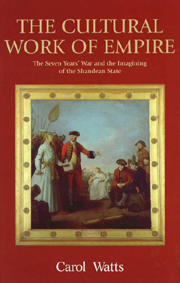Book contents
- Frontmatter
- Contents
- Acknowledgements
- List of Illustrations
- Abbreviations
- INTRODUCTION: THE CULTURAL WORK OF EMPIRE
- 1 LUNACY IN THE COSMOPOLIS (1759): EXPANSION AND IMPERIAL RECOIL
- 2 PATRIOT GAMES: MILITARY MASCULINITY AND THE RECOMPENSE OF VIRTUE
- 3 PRICKSONGS IN GOTHAM: OR, THE SEXUAL OECONOMY OF STATE IMAGINING
- 4 FRIENDSHIP, SLAVERY AND THE POLITICS OF PITY, INCLUDING A VISIT FROM PHILLIS WHEATLEY
- 5 WOMEN'S TIME AND WORK-DISCIPLINE: OR, THE SECRET HISTORY OF ‘POOR MARIA’
- 6 ‘BRAMIN, BRAMINE’: STERNE, ELIZA DRAPER AND THE PASSAGE TO INDIA
- 7 CONCLUDING ALONG SHANDEAN LINES
- Bibliography
- Index
2 - PATRIOT GAMES: MILITARY MASCULINITY AND THE RECOMPENSE OF VIRTUE
Published online by Cambridge University Press: 12 September 2012
- Frontmatter
- Contents
- Acknowledgements
- List of Illustrations
- Abbreviations
- INTRODUCTION: THE CULTURAL WORK OF EMPIRE
- 1 LUNACY IN THE COSMOPOLIS (1759): EXPANSION AND IMPERIAL RECOIL
- 2 PATRIOT GAMES: MILITARY MASCULINITY AND THE RECOMPENSE OF VIRTUE
- 3 PRICKSONGS IN GOTHAM: OR, THE SEXUAL OECONOMY OF STATE IMAGINING
- 4 FRIENDSHIP, SLAVERY AND THE POLITICS OF PITY, INCLUDING A VISIT FROM PHILLIS WHEATLEY
- 5 WOMEN'S TIME AND WORK-DISCIPLINE: OR, THE SECRET HISTORY OF ‘POOR MARIA’
- 6 ‘BRAMIN, BRAMINE’: STERNE, ELIZA DRAPER AND THE PASSAGE TO INDIA
- 7 CONCLUDING ALONG SHANDEAN LINES
- Bibliography
- Index
Summary
In late 1761 the first of a series of four large history paintings by Francis Hayman was exhibited at Vauxhall Gardens. It commemorated the taking of Montreal by General Amherst in the previous year, an event which had effectively secured Canada for the British following Wolfe's success in Quebec. The Surrender of Montreal to General Amherst portrayed a humanitarian act of relief, in which the General was shown extending his arms compassionately to the kneeling population of the city – both French and Indian – who had starved under siege. The painting was inscribed, according to a guidebook, with the words: ‘POWER EXERTED, CONQUEST OBTAINED, MERCY SHOWN! MDCCLX’. It testified to the fact, as the account put it, that ‘clemency is the genius of the British nation’: and thus to a seemingly just economy of military power, the eighteenth-century equivalent of ‘precision’ warfare. The minimum of expenditure obtains the rightful end, and the remainder is mercy. This equation provided the kernel of the ideological justification for British imperial conquest as simultaneously expedient and improving, a conquest that subjugated peoples might eventually come to be grateful for. Hayman's painting exhibited the iconic density of such a belief, invoking classical models of victorious magnanimity – the figures of Scipio Africanus and Alexander – melded with Christian charity. It also captured the centrality of a particular mid-century construction of masculinity, in which the man of feeling was put to work in the interests of the state: a cultural work which is the focus of my interest here.
- Type
- Chapter
- Information
- The Cultural Work of EmpireThe Seven Years' War and the Imagining of the Shandean State, pp. 65 - 108Publisher: Edinburgh University PressPrint publication year: 2007



